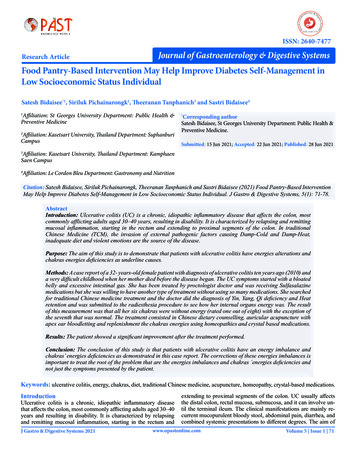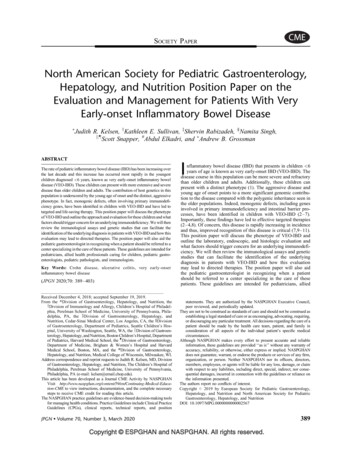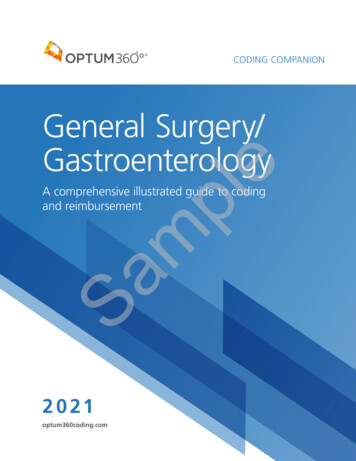
Transcription
ISSN: 2640-7477Research ArticleJournal of Gastroenterology & Digestive SystemsFood Pantry-Based Intervention May Help Improve Diabetes Self-Management inLow Socioeconomic Status IndividualSatesh Bidaisee*1, Siriluk Pichainarongk2, Theeranan Tanphanich3 and Sastri Bidaisee4Affiliation: St Georges University Department: Public Health &Preventive Medicine1Affiliation: Kasetsart University, Thailand Department: SuphanburiCampus2Corresponding authorSatesh Bidaisee, St Georges University Department: Public Health &Preventive Medicine.*Submitted: 15 Jun 2021; Accepted: 22 Jun 2021; Published: 28 Jun 2021Affiliation: Kasetsart University, Thailand Department: KamphaenSaen Campus3Affiliation: Le Cordon Bleu Department: Gastronomy and Nutrition4Citation: Satesh Bidaisee, Siriluk Pichainarongk, Theeranan Tanphanich and Sastri Bidaisee (2021) Food Pantry-Based InterventionMay Help Improve Diabetes Self-Management in Low Socioeconomic Status Individual. J Gastro & Digestive Systems, 5(1): 71-78.AbstractIntroduction: Ulcerative colitis (UC) is a chronic, idiopathic inflammatory disease that affects the colon, mostcommonly afflicting adults aged 30–40 years, resulting in disability. It is characterized by relapsing and remittingmucosal inflammation, starting in the rectum and extending to proximal segments of the colon. In traditionalChinese Medicine (TCM), the invasion of external pathogenic factors causing Damp-Cold and Damp-Heat,inadequate diet and violent emotions are the source of the disease.Purpose: The aim of this study is to demonstrate that patients with ulcerative colitis have energies alterations andchakras energies deficiencies as underline causes.Methods: A case report of a 32- years-old female patient with diagnosis of ulcerative colitis ten years ago (2010) anda very difficult childhood when her mother died before the disease began. The UC symptoms started with a bloatedbelly and excessive intestinal gas. She has been treated by proctologist doctor and was receiving Sulfasalazinemedications but she was willing to have another type of treatment without using so many medications. She searchedfor traditional Chinese medicine treatment and the doctor did the diagnosis of Yin, Yang, Qi deficiency and Heatretention and was submitted to the radiesthesia procedure to see how her internal organs energy was. The resultof this measurement was that all her six chakras were without energy (rated one out of eight) with the exception ofthe seventh that was normal. The treatment consisted in Chinese dietary counselling, auricular acupuncture withapex ear bloodletting and replenishment the chakras energies using homeopathies and crystal based medications.Results: The patient showed a significant improvement after the treatment performed.Conclusion: The conclusion of this study is that patients with ulcerative colitis have an energy imbalance andchakras’ energies deficiencies as demonstrated in this case report. The corrections of these energies imbalances isimportant to treat the root of the problem that are the energies imbalances and chakras energies deficiencies andnot just the symptoms presented by the patient.Keywords: ulcerative colitis, energy, chakras, diet, traditional Chinese medicine, acupuncture, homeopathy, crystal-based medications.IntroductionUlcerative colitis is a chronic, idiopathic inflammatory diseasethat affects the colon, most commonly afflicting adults aged 30–40years and resulting in disability. It is characterized by relapsingand remitting mucosal inflammation, starting in the rectum andJ Gastro & Digestive Systems 2021extending to proximal segments of the colon. UC usually affectsthe distal colon, rectal mucosa, submucosa, and it can involve until the terminal ileum. The clinical manifestations are mainly recurrent mucopurulent bloody stool, abdominal pain, diarrhea, andcombined systemic presentations to different degrees. The aim ofwww.opastonline.comVolume 5 Issue 1 71
therapy is to induce and maintain clinical and endoscopic remission. Colectomy is needed in up to 15% of patients with ulcerativecolitis.In Western medicine, amino salicylates are the main choice oftreatment for mild to moderate ulcerative colitis, topical and systemic steroids can be used to treat ulcerative colitis flares, whileimmunosuppressant and biological drugs are used in moderate tosevere disease (1). The etiology of ulcerative colitis in Westernmedicine remains unknown. The genetic factor must be valued,since there is a greater family incidence in the general population. Psychological factors are considered strong contributors andprecipitants of the disease in most cases, even if they cannot beconsidered causative agents (2). The diagnosis of clinical manifestations of UC lesions under colonoscopy exam, the applicationof pathological examinations, endoscopic mucosal staining techniques, and magnification endoscopy are increasing the scientificrigor of diagnosis. In traditional Chinese Medicine, emotional factors may be the cause triggering attacks of ulcerative colitis. Theinvasion of external Humidity, Cold and Heat, leading to DampCold and Damp-Heat alterations, inadequate diet, violent emotionsand constitutional deficiencies are the sources of the disease (3).Constitutional deficiencies usually refer to Spleen and kidney deficiencies. Invasion of exterior pathogenic factors refers to DampHeat in the Large Intestine and Damp-Cold in the Spleen causedby unbalanced diet high in raw food or cold injures the Spleen andStomach can obstruct their functions in transforming and transporting food and nutrients.PurposeThe purpose of this article is based on the thoughts of Hippocrates,the father of Medicine, who says that it is very important to takeinto consideration the oldest medicines before the medicine currently used. This study pretends to demonstrated that patients withulcerative colitis have energies alterations and chakras’ energiesdeficiencies. The corrections of these energies imbalances throughchanging dietary habits according to Chinese dietary nutrition,acupuncture with apex ear bloodletting and replenishing the energies of the chakras’ energies centers using highly diluted medications according to the theory Constitutional Homeopathy of FiveElements based on Traditional Chinese Medicine and crystal basedmedications are important tools to treat these kind of patients withthis diagnosis.health system in Brazil denied this exam and she didn t perform it.In 2011, the symptoms worsened when it was indicated again thecolonoscopy exam. The result of this exam was that she was withulcerative colitis, described to her as a chronic incurable disease,which she would have to intake medications throughout her wholelife, even when the symptoms stop for a while in the remissionphase. When the disease is in crisis, the patient need to ingest several drugs, such as antibiotics, corticosteroids, probiotics and vitamins. She goes to the bathroom several times during the day andher body cannot absorb the nutrients fast enough before she evacuates them, and for this reason, she loses a lot of weight and health.When asked her about any emotional crisis, the patient said thatshe had a very difficult life throughout her childhood when hermother died when she was three years old and after this, she wastaken care by several relatives, and always changing houses andher routine. She was very close to her sister as a child but her sisterhad to be separated from her to be cared for by another relative.Their separation was a bad mark for her. She cites that in additionof her problems during childhood without a family of her own, shealso had recently broken up with a boyfriend and was suffering alot. The author asked her about how ulcerative colitis was affectingher life, she told her that she felt very sadly because she got afraidof social events and leaving her house, because when the pain ofthe cramps comes, she has to rush to the bathroom. Her work lifewas also affected by these symptoms.On her first medical appointment, the doctor did the diagnosis intraditional Chinese medicine of Yin, Yang and Qi deficiency withHeat retention, because she fells hot waves during the day (Yindeficiency) and fells cold in the extremities (Yang deficiency). Shealso fell excessive sweeting during the day (Qi deficiency) and badbreath and itchy in the skin (Heat retention). It was recommendedto measure her seven chakras’ using radiesthesia procedure and theresult of this measurement was that all her six chakras were in thelowest level of energy (rated in one out of eight). Only the seventhchakra was in the normal level (rated in eight).MethodsThe methods used integrated a literature review of the ulcerativecolitis articles in Western medicine and traditional Chinese medicine indexed in PubMed, and a case report of a 32 years-old femalepatient with this diagnosis.Case ReportC.S, 32 years-old female patient, works as a nurse. She presented adiagnose of ulcerative colitis from ten years ago (2010). The ulcerative colitis symptoms started with a bloated belly and excessivegas in 2010. She noticed at that time that her stools were loose,with mucus and blood, some days going to the bathroom overeight times with diarrhea. The patient also reported feeling severecramps. The doctor requested a colonoscopy exam but the publicJ Gastro & Digestive Systems 2021Figure 1: Chakra’s energies meridians deficient in energy with theexception of the seventh.The first step of the treatment was changing her diet through Chinese nutritional therapy. She was counselled to avoid dairy products, raw food, cold beverages and sweets, to avoid the Spleen-pan-www.opastonline.comVolume 5 Issue 1 72
creas deficiency. It was also recommended for the patient to avoidcoffee; soda and matte tea, to avoid the Kidney deficiency. It wasrecommended to avoid chocolate, fried foods, honey, eggs, pepper,coconut, alcoholic beverages and melted cheese to avoid the formation of internal Heat.The second step in the treatment was to balance the internal energies of Yin, Yang, Qi and Blood, using auricular acupuncture andit was necessary to take out the Heat retention through the use ofapex ear bloodletting that was causing the ulcerative colitis inflammatory process and the bleeding from the stools.ResultsThe patient showed a significant improvement after the treatmentperformed reducing the diarrhea symptoms and the abdominalpain reduced too. She affirmed that her mood improved and herenergy to the daily activities and she was very happy with the results as the treatment were done in the deepest level of the energydisharmony, although she continues with the Western medicinemedication. In her latest visits, the patient shared she was oftenfeeling breathless, which the doctor said that the symptoms werealso related to her chakras’ energies deficiencies, specifically bythe deficiency of the second chakra represented by the Kidney inTCM. In TCM reasoning, the Kidney meridian receives energyfrom the Lung meridian and when the Kidney is without energy,this transmission of energy is interrupted and can cause dyspneasymptoms.This lack of breath was quickly dealt with the replenishment of thechakras energy using highly diluted medications according to thetheory Constitutional Homeopathy of Five Elements Based on Traditional Chinese Medicine when she was orientated to intake eachmedication on a daily basis, instead of each three days, because thepatient was in a condition that needs urgent care to prevent furtherhospitalization.DiscussionUlcerative colitis (UC) is understood as a chronic inflammatorycondition causing continuous mucosal inflammation of the colonwithout granulomas on biopsy, affecting the rectum and a variableextent of the colon in continuity, which is characterized by a relapsing and remitting course (4).Figure 2: Auricular Acupuncture PointsAt last, the patient was prescribed treatment for replenishment ofthe chakras’ energies with homeopathies, according to Constitutional Homeopathy of the Five Elements Based on Traditional Chinese Medicine, created by author and crystal based medications.The following homeopathies were prescribed: Sulphur 30CHXX20 (single dose), Calcarea carbonica 30CHXX-20 (single dose),Silicea 30CHXX-20 (single dose), Natrium muriaticum 30CHXX20 (single dose), Phosphorus 30CHXX-20. It was prescribed to betaken in a single dose with a hiatus of three days between the medications, necessarily on the sequence described. Two months later,a new sequence of treatment was started, with the same medications taken on the same order, but now with 200CHXX-20 insteadof 30 CHXX-20. Two months later, a new sequence of treatmentwas started, as the others, with the same medications taken on thesame order, now with 1000CHXX-20 instead of 200CHXX-20.Same order, now with 10000CHXX-20 instead of 1000CHXX-20.Two months later, a new sequence of treatment was started, as theothers, with the same medications taken on the same order, nowwith 50000CHXX-20 instead of 10000CHXX-20. These kind ofmedications are usually recommended to use for a period of oneyear or more, depending on the results of the new chakra’s measurement after one year of treatment.J Gastro & Digestive Systems 2021Colitis is the term best suited for the minority of cases where adefinitive distinction between UC, Crohn’s disease, or other causeof colitis cannot be made after the history, endoscopic appearances, histopathology of multiple mucosal biopsies and appropriateradiology have been taken into account. The first aim of medicalmanagement is to induce and maintain remission with the longterm goals of preventing disability, colectomy, and colorectalcancer (5). The treatment of ulcerative colitis is mainly done byWestern medicine using amino salicylic acid preparations (salazosulfapyridine -SASP and aminosalicylic acid- ASA), steroidhormones, immunosuppressant’s, and new biologics (6). The useof early biological drugs should be considered in patients admitted to hospital with acute severe ulcerative colitis, as well as insteroid-refractory ulcerative colitis. Once remission is induced,medications can be continued or added to maintain remission. Tounderstand how the author did her reasoning to treat this patientpresented in the case report, in the past years, the author has beenpublishing several studies, all aiming to stablish the significanceand effectiveness of an integral and individualized perspective,when treating patients for the most varied pathologies (7-8).This concept begins during the treatment of one particular patientin 2006. This patient was a 70-year-old male, who related pain inthe legs and was diagnosed with Kidney-Yang deficiency, according to TCM. He received treatment with Chinese dietary counselling, acupuncture and auricular acupuncture associated with apexear bloodletting. When the treatment done, the pain in the legsdiminished and the patient was subject to an appointment 30 dayswww.opastonline.comVolume 5 Issue 1 73
after. In this interview, the patient revealed that his eye pressurehad also lowered, confirmed by his ophthalmologist. The doctorwas not aware that the patient had glaucoma and he didn t reportthat he was being treated glaucoma in the last 40 years with noimprovement of his condition that was always more than 40 mmHg in both eyes. With the processing performed, his intraocularpressure lowered to 17 mm Hg.This case became the cornerstone of the author studies in the field,trying to comprehend how the treatment based on the root of theproblem could treat different diseases and symptoms simultaneously and using the same methods. To better explain how the author makes her reasoning, she always like to use the metaphor ofthe tree. The use of this metaphor is usually done to make a comparison of Western medicine from ancient medicines, such as traditional Chinese medicine. On the (figure 3), you can see the root,trunk and several branches. Coming out of each branches, manyleaves. In this representation, each medical specialty is representedby a branch, and the leaves of each branch represent the symptomsand diseases related to each in specialty.In this representation, Western medicine treats all the diseases inthe leaf level. In this article, the author wants to explain that thereis a necessity of correcting the energies imbalances that corresponds to the root level of this tree that is not visible by the nakedeye. In this root, there are the Yin and Yangtheory and the FiveElements theory.considering their dynamic interaction as the essence of all-naturalphenomena and all human situations. Opposites are complementary. To be healthy, we aim for a state of equilibrium between Yinand Yang energies. If there are imbalances between these two energies, symptoms occur, and if not properly treated, consolidates theformation of disease, in this case, ulcerative colitis (11).Figure 4: Yin and Yang.According to traditional Chinese medicine, the Yin and Yang energies are present and are important energies inside the body. Weall have Yin and Yang energies, and to these energies flow insidethe body, there is the necessity of Qi and Blood. To be healthy,the patient need to be in a state of equilibrium between these fourenergies, as the author presented the necessity of treating theseenergies disharmonies to treat all the patient’s symptoms at thesame time, even if the doctor does not know that the patient hadsuch symptom, as she presented this study at Acupuncture researchconference that took place in the Harvard Medical School in Boston, USA, in 2015. The figure of the dynamic between these fourenergies are described in the (Figure 5)Figure 3: Schematic relationship between Western medicine andtraditional Chinese medicine.Yin and Yang are the two reverses forces that are believed to bepresent in all phoneme in the world. In traditional Chinese medicine, the Yin and Yang is the prime and major cornerstone to understand health, diagnosis and treatments (9-10). It is impossibleto understand traditional Chinese medicine without understandingthe main concepts of Yin and Yang. This concepts base everythingin which traditional Chinese medicine believes in terms of treatment and cure of pathologies. Yin and Yang are energy forces thatrule the world. Everything in the universe is composed by Yin andYang, including our body. The Chinese wise men represented thiscomplement of opposites by the archetypal pair, Yin and Yang,J Gastro & Digestive Systems 2021Figure 5: Yin, Yang, Qi and Blood.The Five Elements theory states that there are five elements presentin everything in the world, including our bodies. These elementsare Fire, Earth, Metal, Water and Wood (figure 6). Inside our bodies, specific organs will represent these elements. These organs areconsidered the main organs, and they have extremely importantwww.opastonline.comVolume 5 Issue 1 74
functions in the well-functioning of the body. They are completelyinterconnected, as the main principle of the Five Elements theoryis to understand the idea of cycle, as shown in the figure 5.Figure 6: Generations cycle and control cycle in the Five Elements theory.The Wood element corresponds to the Liver. The Fire elementcorresponds to the Heart. The Earth element corresponds to theSpleen. The Metal element corresponds to the Lungs, and the Water element corresponds to the Kidney. These main organs willsupport (generation cycle) and control each other (control cycle)presented by the Five Elements, as demonstrated in the (figure 6).In the generation cycle, each element originates from the precedent element. In this cycle, Wood generates Fire, Fire generatesEarth, Earth generates Metal, Metal generates Water and Watergenerates Wood. In the article The Geometry of Emotions: UsingChakra Acupuncture and 5-Phase Theory to Describe Personality Archetypes for Clinical Use written by Christopher R Chase,he associates the Five Elements theory with the Chakras’ energymeridians in Ayurveda medicine. To publish this article and usingthis association explained by Christopher, the author is measuringthe energy of the internal organs of the Five Elements using radiesthesia procedure in Ayurveda reasoning, as you can see in the(Figure 7).Figure 7: Chakra’s energies centers and the correlation with theFive Elements and the five massive organs in TCM.J Gastro & Digestive Systems 2021As there are seven chakras and five elements, the first and seventh correspond to Wood (Liver), the second and sixth correspondto Water (Kidney), the third to Fire (Heart), the fourth to Metal(Lung) and the fifth to Earth (Spleen). Each massive organ has ahollow organ as demonstrated in (table 1). Liver or, first chakra,has the eye as external sensory organ, is responsible for vision, andhas the Gall bladder as its hollow organ. Heart, or the third chakra,is responsible for the tongue, and subsequently language and hasthe Small intestine as its hollow organ. Spleen, or fifth chakra, represents the mouth, is responsible for taste, and has the Stomach asits hollow organ. Lungs, or fourth chakra, have the nose as externalsensory organ, are responsible for the sense of smell, and havethe Large intestine as its hollow organ. Kidney, or second chakra,represents the ear, is responsible for the sense of hearing, and hasthe bladder as its hollow organ. In the case of the patient describedin the case report, she has alterations in the Large intestine that isa hollow organ of the Lung, or fourth chakra (12).Table 1: Five Elements, the five massive organs, and their correspondences.This information is important for the Western medicine physician,because the visible symptoms of external sensorial organs are justthe tip of the iceberg. The cause, which is in the root, maybe foundthrough this relation and is invisible by the naked eyes. In the caseof the patient reported in this article, her symptoms were only thetip of the iceberg but the cause of the disease were in the deepestlevel, in the energy level, invisible by naked eyes.The author, through this case report, is demonstrating that thepatient has no energy in all the chakras’ energy centers but thechakra that is responsible for the formation of this disease is thedisequilibrium in the fourth chakra. As the energy in this chakrawas rated in one, in the lowest level of energy, this deficiency wasleading to the formation of internal Heat in the Large intestine,because the Large intestine is the hollow organ that is coupled tothe Lung, as demonstrated in table 1. In the case of this patient, herchronic emotional state of having sadness because of the constantproblems after the dead of her mother since childhood leaded tothe imbalance of the Lung meridian, that can be imbalanced bychronic state of sadness or grief, as demonstrated in the Table 1,and has the Large intestine as the hollow organ. The lack of energyin the chakras ‘center meridians, in this specifically case, in thewww.opastonline.comVolume 5 Issue 1 75
fourth chakra, was causing formation of internal Heat in the hollow organ, that is the Large intestine, leading to the inflammatoryprocess in this organ, and bleeding. In relation to nutrition, theauthor usually uses this aspect in all her treatments because shealways follows what Hippocrates said; Make your food your medicine and your medicine your food. The point of view of Chinesenutritional therapy is different from Western nutritional therapy,because in first case, it is a study of the energy of each food leading to the patient’s energy balance or imbalance. Unlike Westernnutritional therapy, they study the part of chemical composition,biochemistry, vitamins, carbohydrates, proteins, fats etc. and usually don t take into account the energy part of each food (13-14).For this reason, it is of utmost importance, to have the knowledgeof the energy of each food, leading to the energy imbalance of eachindividual, which will depend on the energy imbalance of eachone, the treatment will be individualized.To achieve balance through diet, the author usually takes intoaccount the balance state of the Spleen, Kidney and Liver. TheSpleen is the door for entrance of energy, through absorbing thenutrients that the patient is ingesting, and if it is imbalanced, asdemonstrated in the radiesthesia procedure, that the fifth chakrawas in the lowest level of energy, this means that the food thatthe patient is ingesting is not absorbing adequately, and leading toless formation of Blood. This could be one of the causes that theremaining chakras were in the lowest level of energy, due to thelack of nutrients supply.The foods that usually imbalance the Spleen-pancreas meridian,or fifth chakra, are the ingestion of raw food, cold water, dairyproducts and sweets. In this case, the author usually advice thepatients to eat boiled or grilled foods and drink luck warm water, torebalance this meridian again. The energy of the water is cold andwhen a cold food enters the interior of the body, it generates theformation of an internal Heat, leading to the worsening of the formation of internal Heat in patients who already have internal Heatgenerated by the energy imbalances leading to ulcerative colitissymptoms.To reduce the energy imbalances in the Kidney meridian, responsible for the formation of Yin and Yang energy, the author orientatesthe patients to avoid coffee, soda and matte tea. This orientation isimportant because, as demonstrated in the radiesthesia procedure,the Kidney or second chakra was in the lowest level of energy too,and if the author don t orientate adequately this patient, the treatment could be in vain, because she was toning the meridian but reducing the energy but the wrong eating hobbits. The consequenceof this lack of energy could form more internal Heat, worsening inthis case, the ulcerative colitis symptoms. The last group of foodsthat the author usually asks the patients to avoid are; fried foods,chocolate, honey, eggs, melted cheese, coconut, alcoholic beverages and pepper. For example, when the patient ingests alcoholicbeverages, in this case, beer, this drink has hot energy, and whentaken cold, it will cause the formation of internal Heat because thebeer has hot energy and when taken cold, the cold of the beer turnsinto Heat, forming more internal Heat, worsening the symptomsof ulcerative colitis. When internal Heat builds up, the patient’sbody in an attempt to eliminate this internal Heat can lead to thefollowing symptoms: nasal bleeding; gingival bleeding; micro hematuria; abundant menstrual blood (prolonged in days of the cycleJ Gastro & Digestive Systems 2021and for blood), bad breath; intestinal bleeding, etc.In the case of bleeding from this pathology, it is the manifestationof the internal Heat formation triggered by the energy deficiencyof the patient, or generated by the wrong diet or emotional factors,leading to the formation of internal Heat (Figure 8).Figure 8: Yin, Yang, Qi, Blood and Heat retention.Therefore, in order to treat the bleeding of this pathology, in addition to removing the Heat formation by apex-ear bloodletting andreducing the foods that are generating the Heat formation directly,in the background, we have to treat the energies deficiencies thatare generating the formation of Heat, as demonstrated by the results of radiesthesia procedure of the patient reported in this article. In this case, where all her six chakras were in the lowest levelof energy, this energy deficiency was leading consequently to theformation of internal Heat, and causing the inflammatory processin the intestine. The bleeding process is considered the way thatour body has to eliminate the excessive Heat formation.As each organ is dependent on another organ in the acquisition andtransformation of energy, and one massive organ depends on theother, instead of treating the affected organ, as Western medicinedoes, all the organs that were energy deficient, diagnosed throughenergy measurement by radiesthesia, were treated. For example, inthe case report, despite having ulcerative colitis, which was causedby the deficiency of the fourth chakra, this chakra depended on theenergy of the fifth chakra. However, the fifth chakra depended onthe energy of the third chakra - which also depended on the energyof the first chakra and which depended on the energy of the secondchakra, as demonstrated in the figure 9), in the generation cycle.Figure 9: Generation Cycle in the right and Control Cycle in theleft.www.opastonline.comVolume 5 Issue 1 76
process in the large intestine and leading to more bleeding in thestools (16-22).Figure 10: Chakras’ energies deficiencies in ulcerative colitis patients, mainly the fourth chakra that has the Large intestine as thehollow organHomeopathies and crystal-based medications were used by the author to treat the patient with ulcerative colitis and they are shownin the (table 2).Table 2: Homeopathies and crystal based medications used toreplenish the chakras’ energy meridians.In the article wrote by the author entitled Constitutional Homeopathy of the Five Elements Based on Traditional Chinese Medicine,published by Acta Scientific Medical Sciences on July 2020, theauthor describes how was her reasoning when she created this newtheory using homeopathies medications and associating Chinesemedicine thoughts. [10] In the article entitled Why Are Diabetic Patients Still Having Hyperglycemia despite Diet Regulation,Ant glycemic Medication and Insulin? Published by InternationalJournal of Diabetes & Metabolic Disorders on March 2019, theauthor described the crystal-based medications used in the treatment of replenishment of the chakras energies meridians and theirproperties and the type of each crystal are described in the Table 2(15). The author chooses to use highly diluted medications insteadof highly concentrated medications in this case, because the principals of Arndt Schultz law. The rule states that for all substanc
4Affiliation: Le Cordon Bleu Department: Gastronomy and Nutrition Journal of Gastroenterology & Digestive Systems Satesh Bidaisee*1, Siriluk Pichainarongk2, Theeranan Tanphanich3 and Sastri Bidaisee4 *Corresponding author Satesh Bidaisee, St Georges University Department: Public Health & Preventive Medicine.










